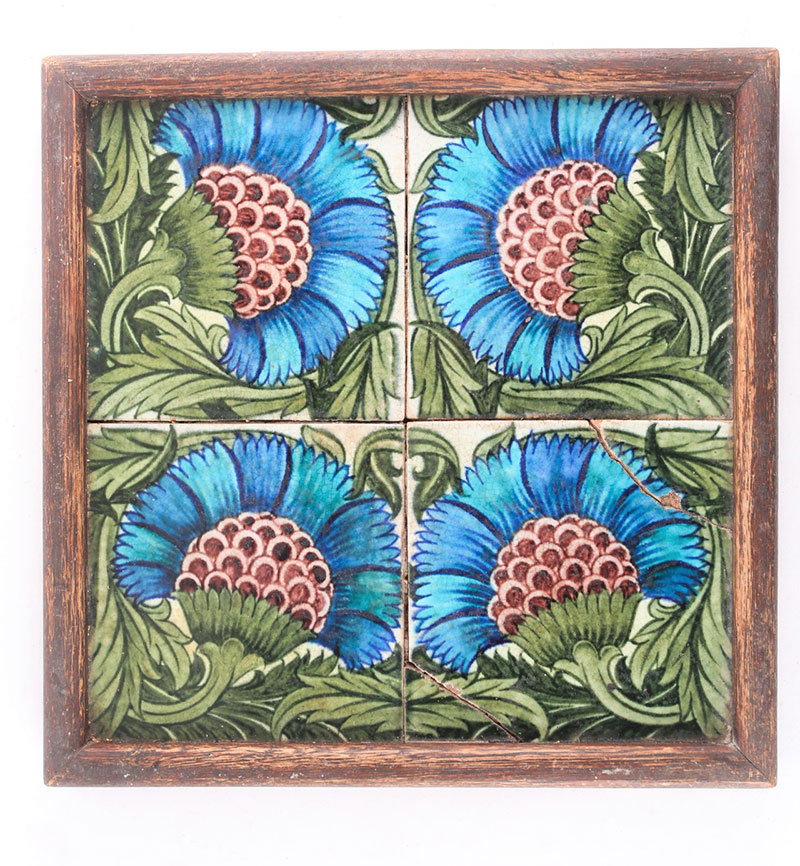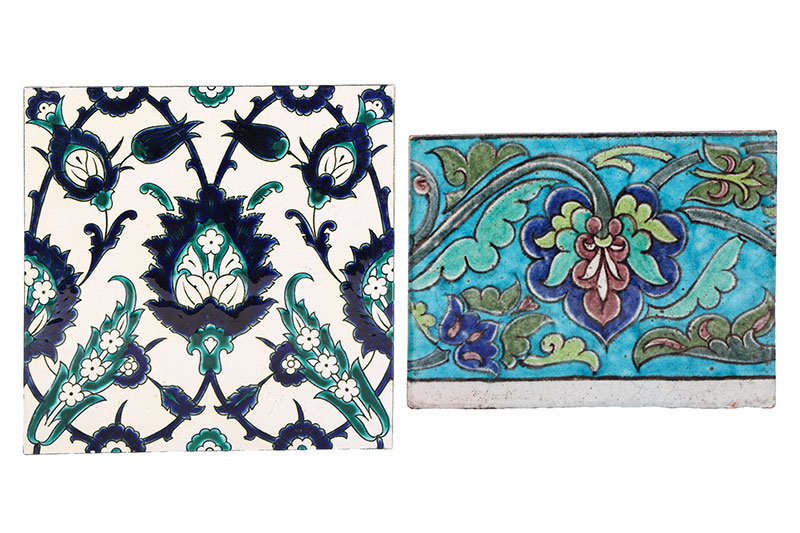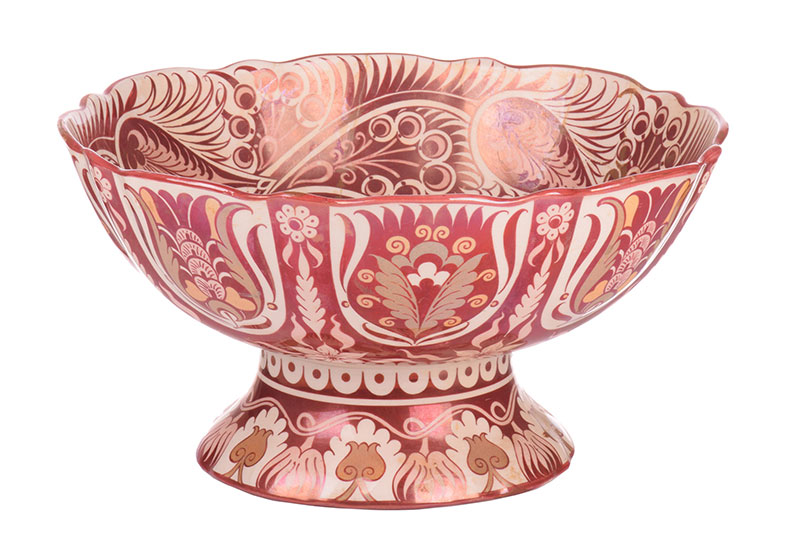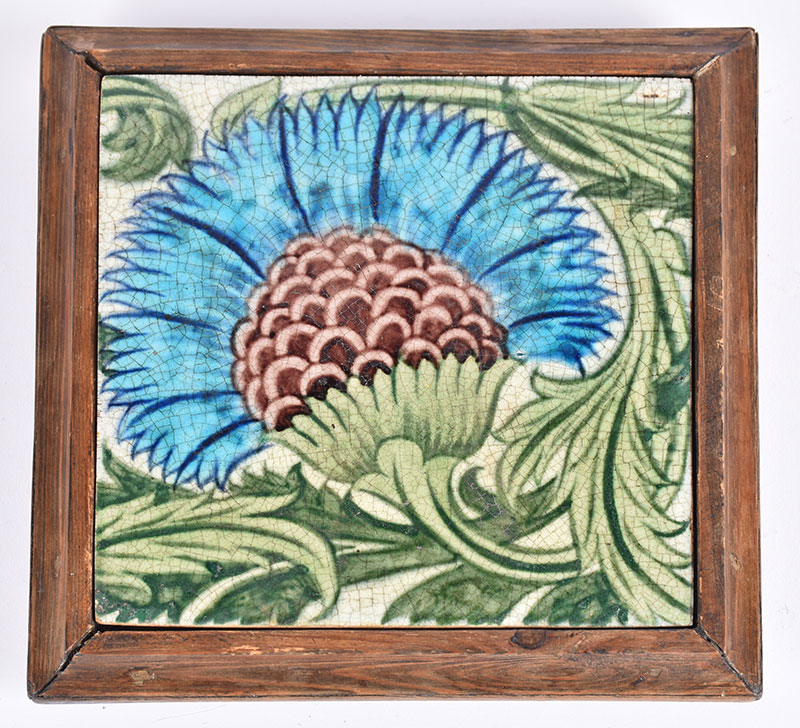A Guide to the Work of William De Morgan
One of the most exciting and important figures in 19th century art
24/06/2024
A key patron of the Arts & Crafts movement, William De Morgan was one of the most exciting and important figures in 19th century art. A prolific designer, potter, novelist, and artist, he is renowned for his tile designs and ceramic wares.
William Frend De Morgan was born to liberal parents, Augustus, and Sophia De Morgan, on the 16th of November 1839. Sophia was an educated woman who advocated for the abolishment of slavery, anti-vivisection, and women’s rights. She was involved with founding the first teaching college for women, and convinced her professor husband, a published authority on mathematics, to lecture at the institute. In deliberate rejection of the institution of religion, Augustus and Sophia were married in St Pancras Registry office.
A William de Morgan Merton Abbey rectangular tile
(Design, Art & Interiors, 16th May, 2024) Sold for £170
By his late teens De Morgan was attending art classes at the Art Academy in Bloomsbury. The sculptured drawings he produced were so exquisite that in 1859 he earned a place at the Royal Academy schools where he began his formal training as an artist, studying fine art. During this time, he met fellow artist Henry Holiday who was associated with the Pre-Raphaelites. In 1863 Holiday introduced De Morgan to William Morris, the pair would become lifelong friends and collaborators.
Shortly after his meeting with William Morris, De Morgan dropped out of the Academy and joined Morris, Marshall, Faulkner & Co. as a designer of stained glass, furniture, and later tiles. It was during the process of creating stained glass that De Morgan’s fascination with a lost glazing technique would emerge; he noticed that when a kiln became starved of oxygen, a metallic deposit would form resulting in an opaque and iridescent finish, known as lustre.
Fred Passenger for William De Morgan, a large footed and shaped pedestal bow
(The December Fine Art & Antiques Auction, 15th Dec, 2023) Sold for £260
In 1872 while experimenting with tiles at his rented studio in Fitzroy Square in London, an incident with his kiln set fire to the roof, necessitating his move to Cheyne Row in Chelsea, where he began working from a small shed at the bottom of the garden. De Morgan employed Frank Iles to manage the kiln and a few painters, most notably brothers Fred and Charles Passenger who would work with him for the remainder of his designing career. Blank tiles were sourced from factories such as Patent Architectural Pottery Co (Poole Pottery), Wedgwood, Minton, and the Morgan Crucible Company, painters would then transfer De Morgan’s designs to these tiles before being fired. Most examples featured floral motifs or posing animals, and some designs such as the “Bedford Park Daisy” & “BBB” became so popular they would remain in production for almost 30 years.
De Morgan was inspired by Middle Eastern art, medieval motifs, Italian renaissance, and the natural world; his use of stylised leaves and flowers in palettes of blues, greens, turquoise, manganese purple, Indian red and lemon yellow became his signature style commonly referred to as “Persian”. Indeed, the most magnificent example of his Islamic influenced tilework is at Leighton house within the Arab Hall. Frederic, later Lord, Leighton commissioned De Morgan to create complimentary examples for his original 15th and 16th century Damascus tiles from Syria. Three years later in 1880, he would be commissioned to make tiles for the interior of an imperial yacht of the House of Romanov, Livadia.
A late 19th Century William De Morgan Sands End pottery "Cornflower" pattern tile
(Fine Art, Antiques & Asian Art, 29th Apr, 2022) Sold for £180
The expanding firm moved to a larger premises, next to William Morris’s textiles workshop, in Merton Abbey, Surrey in 1882. De Morgan shifted focus towards vessels and dishes, employing potters and painters to create his vision. Never learning to throw pots, he supervised operations while continuing to develop his innovative designs and experimental glazing techniques. He was commissioned to supply Iznik-inspired tiles and schemes for the interior of a P & O Ocean Liner, a commission which would go on to expand to twelve cruise ships in total over the following 18 years. In this period De Morgan met and fell in love with Pre-Raphaelite painter, Evelyn Pickering; they were married in 1887.
With the financial support of his wife and new business partner, architect Halsey Ricardo, the pottery was moved closer to home at Sands End in Fulham in 1888. De Morgan designed his own impressive kilns which facilitated an increase in production; the pieces produced during this era are perhaps some of De Morgan’s most ambitious, having mastered his glazing and lustre techniques to perfection. His determination paid off tremendously when he became the world’s leading authority on lustre decoration, invited to speak to the Egyptian government about the process in 1892.
 A set of four William de Morgan BBB 6" tiles
A set of four William de Morgan BBB 6" tiles
(Fine Art, Antiques, Jewellery & Silver, 16th Dec, 2021) Sold for £450
The last commission De Morgan undertook was in 1905 from artist friend, G.F. Watts, who was designing “Monument to Heroic Self Sacrifice”, which can still be viewed today at Postman’s Park in London. Financial hardships and changing tastes led De Morgan to retire from pottery with the factory officially ceasing operations in 1907.
"All my life I have been trying to make beautiful things, and now that I can make them nobody wants them." – William De Morgan.
With the encouragement of his wife, De Morgan pursued a second career as a Fictional writer; releasing his first novel, Joseph Vance, in 1906, which became an instant international sensation. He wrote seven novels and made his fortune doing so.
In 1917 De Morgan contracted urban trench fever (also known as “five-day fever”) and passed away. He was buried in Brookwood Cemetery, in Surrey, in a grave designed by Evelyn De Morgan.
His ability to architect 3D drawings and designs to effectively communicate his vision were exceptional. An inventor by nature, ingenious designer and passionate chemist, De Morgan ceramics and tiles are renowned for their vibrant vivid colours, symmetrical perfectly balanced forms, and intricate captivating designs. His contribution to the arts by reviving of the ancient technique of lustreware will forever be indebted to William De Morgan.
READ MORE
How to Identify Antique Pottery?
Are you considering selling any artwork by William De Morgan?
With a global audience of over 10 million known bidders, Dawsons can help secure the best prices.
Get in touch with an expert valuer for confidential sales advice, we would be delighted to help you:


